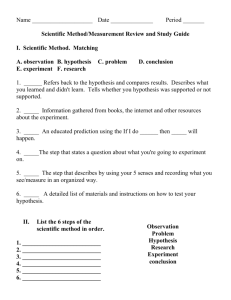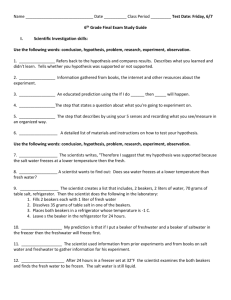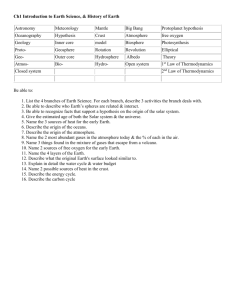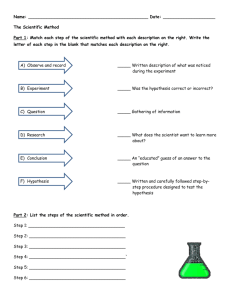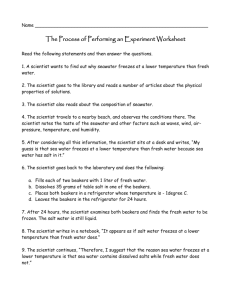IV. Experimental Design. Vocabulary Matching. Word Bank constant
advertisement
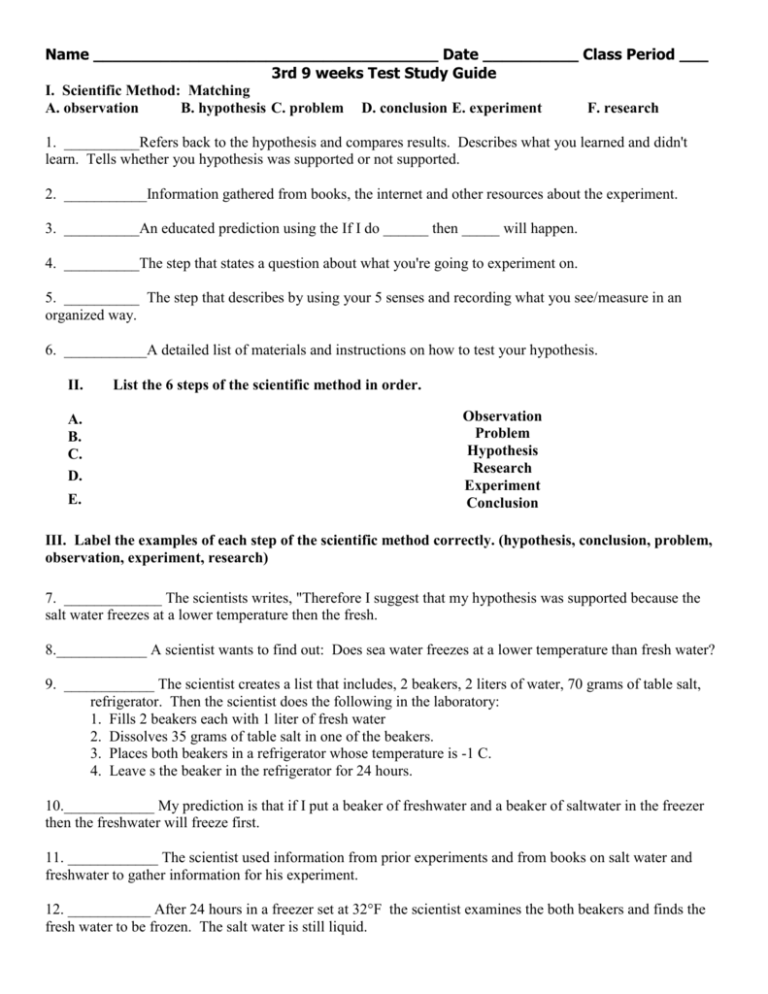
Name ____________________________________ Date __________ Class Period ___ 3rd 9 weeks Test Study Guide I. Scientific Method: Matching A. observation B. hypothesis C. problem D. conclusion E. experiment F. research 1. __________Refers back to the hypothesis and compares results. Describes what you learned and didn't learn. Tells whether you hypothesis was supported or not supported. 2. ___________Information gathered from books, the internet and other resources about the experiment. 3. __________An educated prediction using the If I do ______ then _____ will happen. 4. __________The step that states a question about what you're going to experiment on. 5. __________ The step that describes by using your 5 senses and recording what you see/measure in an organized way. 6. ___________A detailed list of materials and instructions on how to test your hypothesis. II. A. B. C. D. E. List the 6 steps of the scientific method in order. Observation Problem Hypothesis Research Experiment Conclusion III. Label the examples of each step of the scientific method correctly. (hypothesis, conclusion, problem, observation, experiment, research) 7. _____________ The scientists writes, "Therefore I suggest that my hypothesis was supported because the salt water freezes at a lower temperature then the fresh. 8.____________ A scientist wants to find out: Does sea water freezes at a lower temperature than fresh water? 9. ____________ The scientist creates a list that includes, 2 beakers, 2 liters of water, 70 grams of table salt, refrigerator. Then the scientist does the following in the laboratory: 1. Fills 2 beakers each with 1 liter of fresh water 2. Dissolves 35 grams of table salt in one of the beakers. 3. Places both beakers in a refrigerator whose temperature is -1 C. 4. Leave s the beaker in the refrigerator for 24 hours. 10.____________ My prediction is that if I put a beaker of freshwater and a beaker of saltwater in the freezer then the freshwater will freeze first. 11. ____________ The scientist used information from prior experiments and from books on salt water and freshwater to gather information for his experiment. 12. ___________ After 24 hours in a freezer set at 32°F the scientist examines the both beakers and finds the fresh water to be frozen. The salt water is still liquid. IV. Experimental Design. Vocabulary Matching. Word Bank constant, variables, independent variable, dependent variable, repeated trials, control 13. __________The standard for comparison in an experiment. 14.__________ Things that can be changed in an experiment-any changes in an experiment. 15. __________ The variable that is changed on purpose by you. 16. ___________ A term that means you have the same amount of water, same containers, etc. in an experiment -- things that stay the same during the experiment. 17.___________The variable that responds to the change in the experiment. You have no control over this variable. 18. __________The number of times the experiment is done over again. Atoms/Elements/Compound Vocabulary: Use the following words to match each definition: compound, subscript, formula, equation, atom, and element. 19. A pure substance made of only one type of 19)____________________________ atom. 20. A sentence that uses elements and addition signs to show a chemical change. 20)____________________________ 21. The way compounds are written; HO, NaCl. 21)____________________________ 22. The small number to the right of an element symbol; shows the number of atoms in a formula. 22)____________________________ 23)____________________________ 23. The combination of two or more elements. 24. The smallest part of matter/element. 24)____________________________ Energy Vocabulary: Use the following words to match each definition: energy, kinetic, potential, fossil fuels, solar, geothermal, biomass, wind, the sun, hydroelectric, non-renewable, renewable, electricity, transformation. 25. The main use of most energy sources. 26. Energy that can be reused again; we won’t 25)____________________________ 26)____________________________ run out. 27. Energy that CANNOT be reused: we will 27)____________________________ runout. 10. Energy that comes from moving water. 28. The main source of all energy, except 28)___________________________ geothermal. 29. Energy from the uneven heating of the Earth’s surface. 29)__________________________ 30. Energy that comes from burning plants or garbage. 30)__________________________ 31. Energy that comes from heat underneath the surface of the Earth. 31)___________________________ 32) Energy that comes directly from the sun. 32)___________________________ 33) Energy that comes from fossilized dead plants and animals heated under pressure over millions of 33)__________________________ years. 34) Stored energy or energy of position. 34)__________________________ 35) Energy of motion. 35)__________________________ 36) The ability to do work. 36)__________________________ 37) When energy changes from one form to another. 37) _________________________ Environmental Vocabulary: Use the followingpollution, conservation, reduce, recycle, reuse, natural resources. 38)To find another use for an object instead of throwing it away. 38)___________________________ 39)To create less waste. 39)___________________________ 40)The process of making breaking materials into raw materials and remaking them into something new. 41)Anything in the environment used by people. 40)___________________________ 41)___________________________ 42) Any change to the environment that has a negative effect on living things. 42)___________________________ 43)The process of using a resource wisely so it will not be used up. 43)___________________________ True or False. 44. Two or more elements combine to make TRUE or FALSE 44)_______________________ elements. 45. CH4 is a compound. 46. 2oxygen + 4 hydrogen = 2 water 47. An equation is balanced when there are 45)_______________________ 46)_______________________ different amounts of atoms on each side. 47)______________________ 48. Dams on rivers produce geothermal power. 48)______________________ 49. Coal, oil, and natural gas are renewable. 50. The sun is an important source of energy because all parts of Earth get the same amount. 49)______________________ 51. What are the 3 types of fossil fuels? 51) 52. What is produced when two or more atoms/elements combine? 52) 53. List 3 examples of potential energy? 50)______________________ 53) 54. How can you change potential energy? 54) 55. List 3 examples of kinetic energy? 55) 56. What is the main source of all energy (except 56) geothermal)? 57. What is the main use of all energy sources? 58. What is the best way to protect the environment or a 57) 58) sensitive area? 59. What would be the best reason to plant trees in 59) an urban area? 60. Who should help protect the environment? 60) 61. List 5 types of renewable energy. List 3 types of 61) non-renewable energy? 62. Write the energy transformation that occurs when a plant receives energy from the sun. 62) Natural Resource: How are these damaged or Way to protect these polluted : resources. Forests 63. 64. Water 65. 66. Soil 67. 68. 69. 70. 71. 72. Wildlife Air Fill in the blank: Write the correct word for each definition. Use: The Earth’s energy budget, wind, Greenhouse effect, The sun, greenhouse gases conduction, convection, radiation, convection currents 73) The concept that certain gases trap heat in our atmosphere. 73. ____________________________________ 74) This is responsible for powering the atmosphere, oceans, causing weather, providing heat, light, energy, and causing life processes. 74. ______________________________________ 75) The unequal heating and cooling of land and water that causes local winds. 75. _____________________________________ 76) The concept that energy in our atmosphere is balanced by being absorbed and reflected 76. ______________________________________ 77) methane, water vapor, carbon dioxide 77. ______________________________________ 78) The process of warm air rising, cold air sinking in a repeated pattern. 78. ______________________________________ 79. ______________________________________ 79) heat transferred though a liquid or a gas 80. _______________________________________ 80) heat transferred directly from one solid to the next through direct contact. 81. _______________________________________ 81) heat transferred through electromagnetic waves Draw and label an illustration of warm air and cold air for each box. Beside each box tell 3 facts. Warm 82. _________________ 83. _________________ 84. _________________ 85. _________________ Cold 86. _________________ 87. _________________ Convection Conduction Radiation Types of Heat Transfer Choices: Empty space, liquids and gasses, solids Choices: Direct contact, bumping of molecules, no contact needed What can it move through? 88. 89. 90. What kind of contact? 91. 92. 93. Examples: 94. 95. 96. Choices: Heat from a fire or the sun, ice melting in your hand, heat coming from a vent In the chart label the unit of measurement that would be used in the metric system. The base unit has Length Volume Mass been written for you along with abbreviations. Next to Ex: write an example of something that would be measured using that unit of measurement. Word Bank for units of measurement: milligram, kiloliter, centimeter, millimeter, kilometer, kilogram, milliliter, 97.km- 99. kl- 101. kg- 98.Ex: 103. ex 100. Ex: 104. ex- 102. Ex: 105. ex – m-meter 106. cm- l-liter g-gram XXXXXXXXXXX XXXXXXXXXXXX 109. ml- 111. mg- 110. Ex: 112. Ex: Ex: 107. mm108. Ex: 113. Label the following on the electromagnetic 113. spectrum diagram: infrared waves, visible light, ultraviolet light, more energy, less energy. 114. Which part of the electromagnetic spectrum has more energy? How do you know? 114. 115. Which part of the electromagnetic spectrum has less energy? How do you know? 115. 116. Explain the concept of the Earth’s Energy budget. 116. 117. What happens to the sun’s energy when it reaches Earth? 117. 118. List objects that absorb and reflect energy in our atmosphere. 118. 119. What do the arrows moving down represent? 119. 120. Number the following steps in the order they occur in convection currents: 120. ______ The ground heats the air above it through conduction. ______ Cold air sinks. ______ The sun’s radiation warms the ground. ______ Warm air rises through convection. ______ Air cools off high in the atmosphere. ______ The sun’s radiation moves through the atmosphere. _______The cycle repeats itself. List the major layers of the atmosphere, tell their temperature change, and name one thing that you would find in that layer: Word Bank: Stratosphere, mesosphere, troposphere, thermospere 121. Name of Layer What might you find/see in this layer? 122. Temp does what as you rise up into the atmosphere? 123. 125. 126. 127. 128. 129. 130. 131. 132. 133. 134. 135. 136. Earth Earth Earth 124.
